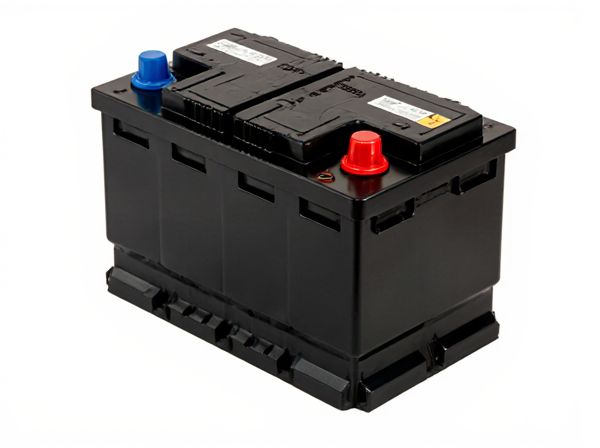
Photo illustration: AGM vs Flooded Cell
AGM batteries offer superior performance and durability compared to flooded cell batteries due to their sealed design and absorbent glass mat technology. Flooded cell batteries require regular maintenance and are prone to acid spillage, making them less convenient and less safe for certain applications. Your choice depends on whether you prioritize low maintenance and safety (AGM) or cost-effectiveness and simplicity (flooded cell).
Table of Comparison
| Feature | AGM Battery | Flooded Cell Battery |
|---|---|---|
| Technology | Absorbent Glass Mat (AGM), sealed | Lead-acid, liquid electrolyte, vented |
| Maintenance | Maintenance-free | Requires regular topping up with distilled water |
| Lifespan | 4-7 years | 3-5 years |
| Durability | Vibration resistant, spill-proof | Less resistant to vibration and spills |
| Cost | Higher upfront cost | Lower initial cost |
| Performance | Faster recharge, better cold-weather performance | Slower recharge, average cold-weather performance |
| Applications | Modern vehicles, high-demand electronics | Standard vehicles, budget-conscious users |
Introduction to AGM and Flooded Cell Batteries
Absorbent Glass Mat (AGM) and Flooded Cell batteries are two common types of lead-acid batteries used in automotive and energy storage applications. AGM batteries feature a fiberglass mat that absorbs the electrolyte, providing maintenance-free operation and improved resistance to vibration and deep discharge. Flooded Cell batteries use a liquid electrolyte that requires regular maintenance, such as checking water levels, and offer cost-effective performance with longer cycle life under controlled conditions.
Understanding AGM (Absorbent Glass Mat) Technology
AGM (Absorbent Glass Mat) batteries utilize a highly porous microfiber separator that absorbs and immobilizes the electrolyte, leading to reduced acid stratification and improved vibration resistance compared to traditional flooded cell batteries. This design enhances charge acceptance and allows for faster recharge times, making AGM batteries ideal for applications requiring high power and deep cycling capabilities. The sealed, maintenance-free nature of AGM technology minimizes electrolyte loss and significantly reduces the risk of acid spills, offering increased safety and reliability.
What are Flooded Cell Batteries?
Flooded cell batteries are a type of lead-acid battery that contains liquid electrolyte, typically a mixture of sulfuric acid and water, which submerges the battery plates. These batteries require regular maintenance, such as checking electrolyte levels and refilling with distilled water to prevent damage and ensure optimal performance. Flooded cell batteries are known for their affordability and durability, commonly used in automotive and deep-cycle applications where weight and maintenance access are less critical.
Key Differences Between AGM and Flooded Cell Batteries
AGM batteries utilize absorbed glass mat separators to immobilize electrolyte, offering superior vibration resistance and faster recharge times compared to flooded cell batteries, which feature liquid electrolyte requiring regular maintenance and ventilation. Flooded cell batteries tend to have a lower upfront cost but are prone to acid stratification and require water refilling, while AGM batteries provide enhanced durability, leak-proof design, and better performance in deep-cycle applications. The energy density and lifespan of AGM batteries generally surpass those of flooded cells, making AGM the preferred choice for high-demand automotive and renewable energy systems.
Performance Comparison: AGM vs Flooded Cell
AGM batteries deliver higher performance with faster recharge times and superior discharge efficiency compared to flooded cell batteries, making them ideal for high-demand applications. Flooded cell batteries, while cost-effective and reliable under moderate conditions, exhibit lower energy density and require regular maintenance due to electrolyte evaporation. AGM technology offers enhanced vibration resistance and longer cycle life, boosting overall efficiency and durability in demanding environments.
Lifespan and Durability: Which Lasts Longer?
AGM batteries typically offer a longer lifespan than flooded cell batteries, often lasting between 5 to 7 years compared to 3 to 5 years for flooded cells. Their sealed, maintenance-free design provides superior durability, resisting vibration, shock, and temperature extremes more effectively. Flooded cells require regular maintenance and are more prone to corrosion and electrolyte spillage, reducing their overall longevity.
Maintenance Requirements: AGM vs Flooded Cell
AGM batteries require minimal maintenance due to their sealed design, eliminating the need for water refills and reducing the risk of acid spills. Flooded cell batteries demand regular maintenance, including checking electrolyte levels and topping up distilled water to prevent damage and ensure optimal performance. Proper maintenance of flooded cells extends their lifespan, while AGM batteries offer a hassle-free, maintenance-free option suitable for demanding applications.
Cost Analysis and Value for Money
AGM batteries typically cost 20-30% more than Flooded Cell batteries but offer longer lifespan and maintenance-free operation, reducing total ownership expenses. Flooded Cell batteries have lower upfront costs but require regular maintenance, which can lead to higher long-term labor and replacement costs. Investing in AGM batteries often yields better value for money in applications where reliability and reduced downtime are critical.
Applications and Suitable Use Cases
AGM batteries are ideal for high-performance applications such as electric vehicles, solar energy storage, and uninterruptible power supplies (UPS) due to their low internal resistance and superior vibration resistance. Flooded cell batteries are commonly used in traditional automotive starting, marine, and industrial backup power applications where cost-efficiency and ease of maintenance are prioritized. Choosing AGM is advantageous in environments requiring deep cycling and fast recharge, while flooded cells excel in large-scale stationary energy storage with simple maintenance needs.
Which Battery is Right for You?
Choosing between AGM and Flooded Cell batteries depends on your specific power needs and maintenance preferences. AGM batteries offer spill-proof design, longer lifespan, and better performance in cold temperatures, making them ideal for RVs, motorcycles, and marine applications where durability and low maintenance are crucial. Flooded Cell batteries are cost-effective with easy monitoring and simple water maintenance, suitable for traditional automotive use and backup power systems where budget and straightforward upkeep are priorities.
 caratoz.com
caratoz.com